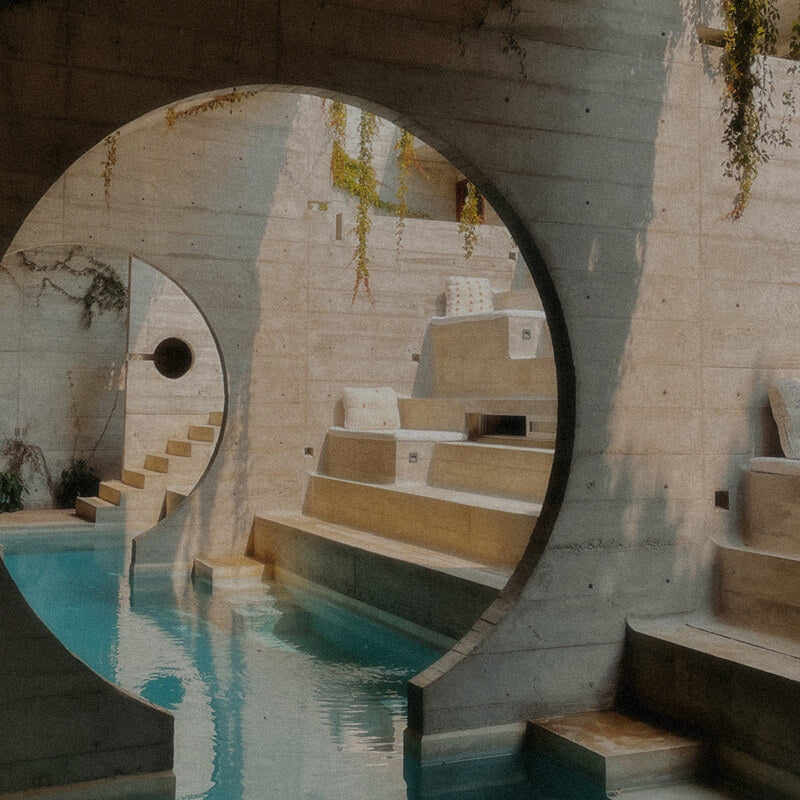
72 Hours in Puerto Escondido
Oaxaca’s Coast at Its Hottest: Three Days of Sun, Salt, and Slow Living
Oaxaca has a pulse unlike anywhere else in Mexico. If Mexico City is a brilliant chaos of color and concrete, Oaxaca feels like something older—earthbound, tender, wildly alive. The food, the textiles, the mezcal. The way light lands on adobe walls at sunset. It's a place that speaks in sensation, not spectacle.
But while the inland highlands of Oaxaca are known for their cool evenings and mountain mist, the coast tells a hotter, saltier story. I visited Puerto Escondido during the off-season—a time when most travelers steer clear. The sun was high and heavy, pushing temperatures past 100°F by noon. It was too hot to move quickly, which was precisely the point. This was a trip meant for slowing down.

Check In, Tune Out
Casa TO sits just minutes from the small, low-key airport, tucked discreetly into the La Punta neighborhood. It’s a brutalist poem written in poured concrete. Designed by architect Ludwig Godefroy, the hotel plays with shadow, silence, and scale. The highlight is the central pool, a long body of water framed by towering concrete columns and oversized stone steps that double as platforms for sunbathing. The air is still, the sun is absolute, and the whole place feels like a temple to rest.
There’s a rhythm to days here. Wake with the light, swim before the heat peaks, take slow sips of coffee under a canopy of hanging vines. The architecture, while stark, cradles you—a cool relief from the outside blaze.
There’s a rhythm to days here
A Stay Powered by Nature
From Casa TO, I traveled north to Hotel Terrestre, an off-grid sanctuary by Grupo Habita. It runs entirely on solar power, a rare and beautiful thing for a luxury hotel. There's no air conditioning. Just fans, open windows, and the sound of wind weaving through the building’s earth-toned clay walls. The design dissolves into the surrounding landscape—a gentle push back against excess.
The hotel practices what it preaches: sustainable tourism without sacrifice. Composting toilets, solar-powered everything, and a serious commitment to preserving the quiet beauty of the coastline. The beach is just a short walk away. Long stretches of untouched sand, wild and wind-whipped, perfect for early morning walks and late-night stargazing.
Rooms are pared back to essentials: clay, wood, linen, and a plunge pool with a view of the Pacific. It was here that I began to understand the true cost of heat.
The Importance of Hydration in Extreme Heat
In the off-season, the heat isn’t just intense—it’s constant. By midday, the temperature hangs heavy and slow, pressing down like a second skin. Hotels offer water, but in climates like this, plain water simply isn’t enough. With every hour of sweat, we lose between 800 to 1200 milligrams of sodium, and 200 to 300 milligrams of potassium. Magnesium loss is harder to measure, but just as essential.
Electrolyte imbalance in high heat can lead to fatigue, brain fog, muscle cramping—a total short-circuiting of the body’s natural rhythms. I had just gotten the first prototypes of The Hydration Trifecta before leaving for the trip, so I decided to pack it.
Each morning, I’d stir a stick into cold water before stepping out into the sun. It became its own kind of ritual: before a beach walk, after sweating through a hike to the cliffs, or just while sitting still, letting the sun press down like a weighted blanket.
There’s a difference between hydration and real hydration. Plain water can’t replenish what heat pulls from your cells. When you’re sweating this much, replenishing with electrolytes becomes non-negotiable. Not for performance. For presence.
By midday, the temperature hangs heavy and slow, pressing down like a second skin.
The Details That Matter
In this part of Oaxaca, connection is currency. Most places near Terrestre are remote. Cell signal is spotty at best, and WiFi only exists in a few tucked-away corners. There are no taxis to hail from the road. Instead, I learned to ask locals for numbers—drivers, surf instructors, fruit vendors. Everyone is on WhatsApp, and most are happy to share their recommendations or offer a ride.
If you go, collect those numbers like keepsakes. They’re your lifeline to the rhythms of this coast: a cab when you need it, a sunrise surf lesson you didn’t know you needed, or the best place for ceviche with a view.
Leaving Slowly
On the last morning, I sat on the platform steps at Casa TO before heading to the airport. The air was already thick with heat, but the stillness felt sacred. In places like this, hydration becomes more than a wellness buzzword—it’s a return to something primal. A way to live in step with the sun, not against it.
Puerto Escondido is not for rushing. It's for leaning into the heat, the silence, the slow.
/J 

